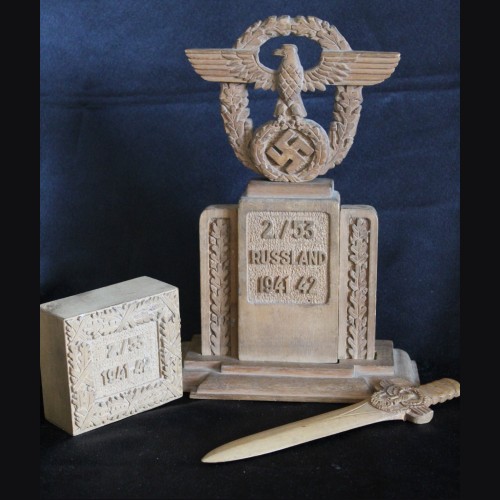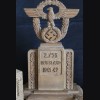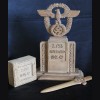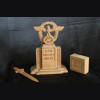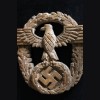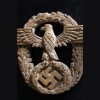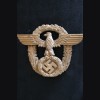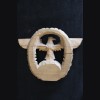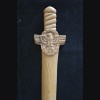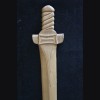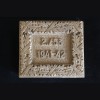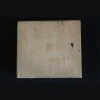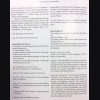Deutsches Polizei Desk Set- Russland
While there is no real shortage of desk sets and ornaments, however; original pieces of quality and or complete sets are just not readily available nor have they been for many years. This example is an original multi piece set, hand carved and not common at all to find in the market place.
The set is comprised of 3 pieces, with the center piece measuring approx. 11 1/2 inches high and 8 inches wide at the base and made of 5 individually hand carved pieces, it is quite a treat to see the work involved in making it and how well is all go's together for display. The center is marked for 2./53 Russland and dated for 1941/42 and flanked by two carved oak leaf pillars that serve as support. The police eagle and wreath at the top is beautifully done and appears to have been carved on one piece of wood but I am uncertain and it could be two as there is a split to the rear and it is either a very old repair or it was done in two pieces, it is difficult to tell actually.
The 2nd piece is manufactured of one piece of wood and serves as a letter opener and measures approx 9 inches long and just over 2 inches wide at what would be the cross guard. The guard is a hand carved police eagle within the wreath and matches the center piece finial and is in high detail.
The 3rd piece is a desk weight measuring 3 1/2 x 4, by 1 3/4, is hand carved and bears the unit info 2./53 1941/42 to match the set and to complete the unit. If your at all familiar with these types of pieces you will certainly enjoy this one as a one of a kind example and as it relates to the Deutsches Polizei. A summary of the unit history is below and who ever made or received this was quite likely a person of importance. Feel free to contact for additional photos or if you have any questions.
The staff of the North Police Regiment was set up in preparation for the Russian campaign in the summer of 1941. The staff was to lead police battalions 22, 53 and 319. With the beginning of the war with Russia on June 22, 1941, the staff was subordinate to the commander of the rear army area 101 (later commander of the rear army area "North"). On October 7, 1941, the regimental headquarters moved from Pleskau to Opochka. During the Russian winter offensive, the regiment from January 10, 1942 as "Group Keuper" the X. Army Corps subordinated and used until March 1942 in space Kakilewo - Nagowo - Rashucha - Yevachnowo - Bubkovschtschina in the 81st Infantry Division at the front , Following this, the regiment was deployed until June 1941 at the 18th Infantry Division in the Staraya-Russa area. In July 1942, it was pulled out of the front. With orders of the RFSS and Chief of the German Police in the Reich Ministry of the Interior, High Command I (O) (3) No. 184/42, Berlin, July 9, 1942 concerning the summary of the police or reserve police battalions to police Regiments and determination of new locations (Appendix), the regiment was renamed the Police Regiment 15 . The police battalions 305, 306 and 310 were as I. - III. Battalion incorporated into the regiment. Subsequently, the regiment moved to southern Russia to the Higher SS and Police Leader "Russia South". The 1st Battalion remained as III. / Police Regiment 16, and was to be replaced by the II / SS Police Regiment 28, but this did not happen for the time being. By early December 1942, the two remaining battalions southeast of Pinsk were in use. During the operations of the regiment in this area against partisans, there were repeated shootings of Polish and Soviet civilians. In late October 1942, parts of the regiment were involved in the evacuation of the ghetto in Pinsk. In early December 1942, the regiment was by train to Walujki on Oskol and then on foot to Tatarino. Here it was used as part of the 2nd Hungarian Army south of Voronezh along the Don. In December 1942 the regiment was subordinated to the combat group "Fegelein" and used in the Donbogen. In the following battles for Taly Goloja, the regiment was smashed in January 1943. The remnants of the regiment were put together with the remains of the police regiment 15 to the fighting group "Josten". In March 1943, the regiment was relocated to Norway to rebuild. Here he was also the II. / Police Regiment 28 as the 1st Battalion fed. On February 24, 1943, police regiments were renamed SS police regiments. The Police Regiment 15 consequently received the designation SS Police Regiment 15 . This decision of the Reichsf¸hrer SS and Chief of the German Police was justified by the "recognition of their particularly brave and successful operation ...". At the end of August 1943, the regiment was transferred to northern Italy. The 1st Battalion was in Turin, the 2nd Battalion in Milan and the III. Stationed in Trieste battalion and used for partisan missions. At the end of the war, the regiment moved to Austria in British captivity.
Literature and sources:
The History of the Ordnungspolizei 1936 - 1945 Part II: The Staffs and Troops of the Ordnungspolizei, Georg Tessin
Waffen-SS and Ordnungspolizei in the war effort 1939 - 1945. An overview on the basis of the field post overview, edited by Georg Tessin and Norbert Kannapin, Biblio-Verlag, Osnabr¸ck 2000
Wolfgang Curilla, The German Ordnungspolizei and the Holocaust in the Baltic States and Belarus, Schˆningh-Verlag Paderborn, 2nd edition 2006
Rolf Michaelis "The use of the Ordnungspolizei 1939-1945", Michaelis-Verlag, Berlin 2008
While there is no real shortage of desk sets and ornaments, however; original pieces of quality and or complete sets are just not readily available nor have they been for many years. This example is an original multi piece set, hand carved and not common at all to find in the market place.
The set is comprised of 3 pieces, with the center piece measuring approx. 11 1/2 inches high and 8 inches wide at the base and made of 5 individually hand carved pieces, it is quite a treat to see the work involved in making it and how well is all go's together for display. The center is marked for 2./53 Russland and dated for 1941/42 and flanked by two carved oak leaf pillars that serve as support. The police eagle and wreath at the top is beautifully done and appears to have been carved on one piece of wood but I am uncertain and it could be two as there is a split to the rear and it is either a very old repair or it was done in two pieces, it is difficult to tell actually.
The 2nd piece is manufactured of one piece of wood and serves as a letter opener and measures approx 9 inches long and just over 2 inches wide at what would be the cross guard. The guard is a hand carved police eagle within the wreath and matches the center piece finial and is in high detail.
The 3rd piece is a desk weight measuring 3 1/2 x 4, by 1 3/4, is hand carved and bears the unit info 2./53 1941/42 to match the set and to complete the unit. If your at all familiar with these types of pieces you will certainly enjoy this one as a one of a kind example and as it relates to the Deutsches Polizei. A summary of the unit history is below and who ever made or received this was quite likely a person of importance. Feel free to contact for additional photos or if you have any questions.
The staff of the North Police Regiment was set up in preparation for the Russian campaign in the summer of 1941. The staff was to lead police battalions 22, 53 and 319. With the beginning of the war with Russia on June 22, 1941, the staff was subordinate to the commander of the rear army area 101 (later commander of the rear army area "North"). On October 7, 1941, the regimental headquarters moved from Pleskau to Opochka. During the Russian winter offensive, the regiment from January 10, 1942 as "Group Keuper" the X. Army Corps subordinated and used until March 1942 in space Kakilewo - Nagowo - Rashucha - Yevachnowo - Bubkovschtschina in the 81st Infantry Division at the front , Following this, the regiment was deployed until June 1941 at the 18th Infantry Division in the Staraya-Russa area. In July 1942, it was pulled out of the front. With orders of the RFSS and Chief of the German Police in the Reich Ministry of the Interior, High Command I (O) (3) No. 184/42, Berlin, July 9, 1942 concerning the summary of the police or reserve police battalions to police Regiments and determination of new locations (Appendix), the regiment was renamed the Police Regiment 15 . The police battalions 305, 306 and 310 were as I. - III. Battalion incorporated into the regiment. Subsequently, the regiment moved to southern Russia to the Higher SS and Police Leader "Russia South". The 1st Battalion remained as III. / Police Regiment 16, and was to be replaced by the II / SS Police Regiment 28, but this did not happen for the time being. By early December 1942, the two remaining battalions southeast of Pinsk were in use. During the operations of the regiment in this area against partisans, there were repeated shootings of Polish and Soviet civilians. In late October 1942, parts of the regiment were involved in the evacuation of the ghetto in Pinsk. In early December 1942, the regiment was by train to Walujki on Oskol and then on foot to Tatarino. Here it was used as part of the 2nd Hungarian Army south of Voronezh along the Don. In December 1942 the regiment was subordinated to the combat group "Fegelein" and used in the Donbogen. In the following battles for Taly Goloja, the regiment was smashed in January 1943. The remnants of the regiment were put together with the remains of the police regiment 15 to the fighting group "Josten". In March 1943, the regiment was relocated to Norway to rebuild. Here he was also the II. / Police Regiment 28 as the 1st Battalion fed. On February 24, 1943, police regiments were renamed SS police regiments. The Police Regiment 15 consequently received the designation SS Police Regiment 15 . This decision of the Reichsf¸hrer SS and Chief of the German Police was justified by the "recognition of their particularly brave and successful operation ...". At the end of August 1943, the regiment was transferred to northern Italy. The 1st Battalion was in Turin, the 2nd Battalion in Milan and the III. Stationed in Trieste battalion and used for partisan missions. At the end of the war, the regiment moved to Austria in British captivity.
Literature and sources:
The History of the Ordnungspolizei 1936 - 1945 Part II: The Staffs and Troops of the Ordnungspolizei, Georg Tessin
Waffen-SS and Ordnungspolizei in the war effort 1939 - 1945. An overview on the basis of the field post overview, edited by Georg Tessin and Norbert Kannapin, Biblio-Verlag, Osnabr¸ck 2000
Wolfgang Curilla, The German Ordnungspolizei and the Holocaust in the Baltic States and Belarus, Schˆningh-Verlag Paderborn, 2nd edition 2006
Rolf Michaelis "The use of the Ordnungspolizei 1939-1945", Michaelis-Verlag, Berlin 2008


